
Hamsters are rodents belonging to the subfamily Cricetinae, which contains 19 species classified in seven genera. They have become established as popular small pets. The best-known species of hamster is the golden or Syrian hamster, which is the type most commonly kept as a pet. Other hamster species commonly kept as pets are the three species of dwarf hamster, Campbell's dwarf hamster, the winter white dwarf hamster and the Roborovski hamster.
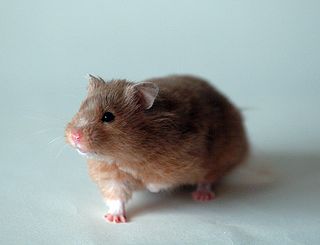
The golden hamster or Syrian hamster is a rodent belonging to the hamster subfamily, Cricetinae. Their natural geographical range is in an arid region of northern Syria and southern Turkey. Their numbers have been declining in the wild due to a loss of habitat from agriculture and deliberate elimination by humans. Thus, wild golden hamsters are now considered endangered by the International Union for Conservation of Nature. However, captive breeding programs are well established, and captive-bred golden hamsters are often kept as small house pets. They are also used as scientific research animals.

The Turkish hamster, also referred to as Brandt's hamster, Azerbaijani hamster, or avurtlak, is a species of hamster native to Turkey, Azerbaijan and other surrounding nations. The Turkish hamster, first catalogued in 1878, is a fairly close relative of the Syrian or golden hamster, though far less is known about it, and it is rarely kept as a pet. The population of the Turkish hamster is said to be declining in the wild, yet this hamster is often used in laboratory testing. Turkish hamsters have lifespans of about two years and are solitary, nocturnal animals, which practice hibernation. They are reported to be more aggressive than other members of the family Cricetidae. They are tan and dark, sandy brown in color. Like all hamsters, the Turkish hamster has cheek pouches that allow it to carry large amounts of food at one time.
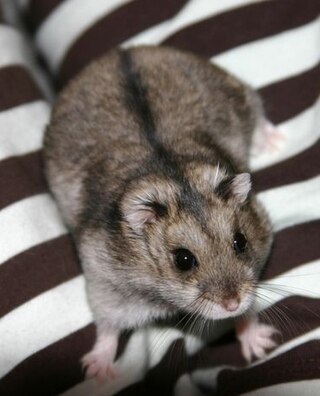
Campbell's dwarf hamster is a species of hamster in the genus Phodopus. It was given its common name by Oldfield Thomas in honor of Charles William Campbell, who collected the first specimen in Mongolia on July 1, 1902. It is distinguished from the closely related Djungarian hamster as it has smaller ears and no dark fur on its crown. Campbell's dwarf hamster typically has a narrow dorsal stripe compared to the Djungarian hamster and grey fur on the stomach. This hamster may be raised in captivity and kept as a small pet.

Phodopus, a genus of rodents in the hamster subfamily Cricetinae—a division of the larger family Cricetidae—is a lineage of small hamsters native to central Asia that display unusual adaptations to extreme temperatures. They are the only known hamsters that live in groups and, in some cases, rely on significant contributions by males to the raising of offspring. They are nocturnal and active throughout the year; they do not hibernate. Species of Phodopus, together with members of the genera Cricetulus, Allocricetulus and Tscherskia are called dwarf hamsters because of their small size relative to other hamsters.

The Roborovski hamster, also known as the desert hamster, Robo dwarf hamster or simply dwarf hamster is the smallest of three species of hamster in the genus Phodopus. It lives in the deserts of Central Asia, averaging 2 centimetres (0.8 in) at birth and 5 centimetres (2.0 in) and 20–25 grams (0.71–0.88 oz) during adulthood. Distinguishing characteristics of the Roborovskis are eyebrow-like white spots and the lack of any dorsal stripe. The average lifespan for the Roborovski hamster is 2–4 years, though this is dependent on living conditions. Roborovskis are known for their speed and have been said to run up to 6 miles a night.
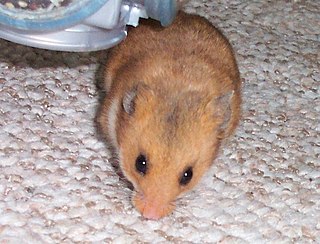
Mesocricetus is a genus of Old World hamsters, including the Syrian or golden hamster, the first hamster to be introduced as a domestic pet, and still the most popular species of hamster for that purpose.

The European hamster, also known as the Eurasian hamster, black-bellied hamster or common hamster, is the only species of hamster in the genus Cricetus. It is native to grassland and similar habitats in a large part of Eurasia, extending from Belgium to the Altai Mountains and Yenisey River in Russia. Historically, it was considered a farmland pest and had been trapped for its fur. Its population has declined drastically in recent years and is now considered critically endangered. The main threats to the species are thought to be intensive agriculture, habitat destruction, and persecution by farmers.

The Chinese striped hamster, also known as the striped dwarf hamster, is a species of hamster. It is distributed across North Asia from southern Siberia through Mongolia and northeastern China to northern North Korea. An adult Chinese striped hamster weighs 20 to 35 g, and has a body length of 72 to 116 mm with a tail of 15 to 26 mm. It is smaller and has a much shorter tail than the greater long-tailed hamster, Tscherskia triton, which inhabits much of the same range.
The Kam dwarf hamster is a species of rodent in the family Cricetidae. It is found only in the mountains of western China where it inhabits grassland, shrubby marshes and steppes. Although it has a limited range, the International Union for Conservation of Nature has assessed its conservation status as being of "least concern".
The long-tailed dwarf hamster is a species of rodent in the family Cricetidae. It is found in China, Kazakhstan, Mongolia, and Russia.
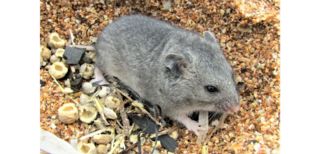
The grey dwarf hamster, grey hamster or migratory hamster is a species of rodent in the family Cricetidae. Its range extends from Eastern Europe through the Middle East, Russia and Central Asia to Mongolia and western China. The grey dwarf hamster has grey fur and a head-body length ranging from 85 to 120 mm. The International Union for Conservation of Nature has assessed its conservation status as being of "least concern".
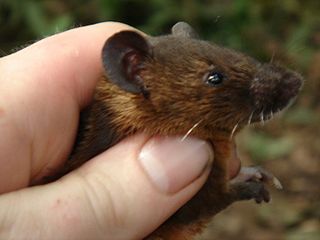
The rusty-bellied brush-furred rat is a species of rodent in the family Muridae. It is found in Angola, Benin, Cameroon, Central African Republic, Republic of the Congo, Democratic Republic of the Congo, Ivory Coast, Equatorial Guinea, Gabon, Ghana, Guinea, Kenya, Liberia, Nigeria, Sierra Leone, Tanzania, Togo, and Uganda. Its natural habitats are subtropical or tropical moist lowland forests, subtropical or tropical seasonally wet or flooded lowland grassland, arable land, and pastureland.
The Ciscaucasian hamster is a species of rodent in the family Cricetidae. It is also known as the Georgian hamster and is found only in Georgia and Russia.

The Mexican agouti,, also known as the Mexican black agouti, is 1 of 13 species of rodent in the genus Dasyprocta. This species was first discovered in 1860 in Veracruz, Mexico and described by Henri Louis Frédéric de Saussure.

Merriam's kangaroo rat is a species of rodent in the family Heteromyidae. The species name commemorates Clinton Hart Merriam. It is found in the Upper and Lower Sonoran life zones of the southwestern United States, Baja California, and northern Mexico.

Allen's chipmunk, also known as the shadow chipmunk, is a species of chipmunk native to the western United States. Occurring in California, Oregon, and Nevada, it is a common species of the Sierra Nevada.

The Lodgepole chipmunk is a species of rodent in the family Sciuridae. It is found in the U.S. state of California at elevations from 1,500 to 3,000 metres. The Lodgepole chipmunk has a variety of common names including: Tahoe chipmunk, Sequoia chipmunk, Mt. Pinos chipmunk, and San Bernardino chipmunk.

Cheek pouches are pockets on both sides of the head of some mammals between the jaw and the cheek. They can be found on mammals including the platypus, some rodents, and most monkeys, as well as the marsupial koala. The cheek pouches of chipmunks can reach the size of their body when full.
The Lama dwarf hamster is a species of rodent in the family Cricetidae. It is found only in the mountains of western China where it inhabits grassland, shrubby marshes and steppes. Although it has a limited range, the International Union for Conservation of Nature has assessed its conservation status as being of "least concern".

















